30 Types of Spices: Ultimate List of Spices with Pictures and Names

Using different types of spices in your cooking can turn a bland dish into a one bursting full of flavor and aromas. There are all sorts of spices you can use in many cuisines from around the world. The list of aromatic spices is almost endless. Some fragrant spices include cumin, nutmeg, cardamom, and cinnamon to give dishes a wonderful aroma and taste. To add a bit of kick or heat, you could spice up a meal with garlic, chili, ginger, or mustard seeds.
But you may be struggling to tell your cumin apart from coriander seeds. Or, you may just be wondering how to make a curry spice. You may want to make sure you have a complete list of Indian or Caribbean spices such as cinnamon, ginger, nutmeg, chili, paprika, and garlic.
Humankind has been using spices in cooking since ancient times. It is thought that the oldest spices used to prepare food were cinnamon and black pepper. When merchants started traveling to distant lands, they took local spices with them and returned with new and unusual spices. Spices such as nutmeg, cloves, ginger, cumin, and pepper were some of the most commonly traded spices in the world.
In this article, you will learn about the most common spices used in many types of world cuisine. You will also find out how to use different spices to make flavorful, fragrant, and tasty meals and desserts.
What’s the difference between herbs and spices?
Before we look at the list of spices, it’s essential to know the difference between herbs and spices.
It can be confusing because sometimes certain spices can be listed as herbs. So, on a list of fragrant spices, you may find coriander, garlic, ginger, fennel, and turmeric. However, these same ingredients could be on a list of aromatic herbs. So, what’s the difference?
Herbs are typically derived from the leafy green parts of a plant and can be used fresh or dried. Examples of herbs include parsley, basil, and thyme. Spices, on the other hand, are obtained from roots, bark, seeds, or fruits of plants, like cinnamon (bark), black pepper (fruit), and ginger (root). Generally, spices have a stronger, more potent flavor compared to the more subtle and fresh flavors of herbs.
List of Spices
Types of spices can be categorized by the part of the plant they are from, the kind of flavor, or by the spice mixture. For example, Cajun spice, curry spice, jerk spice, and garam masala are all spice combinations using several spices.
Here is the list of some spices grouped by their flavors:
- Hot spices include pepper, cayenne pepper, hot paprika, chili, and fennel.
- Sweet spices are ones such as allspice, cardamom, cinnamon, saffron, and coriander.
- Common spices can include cinnamon, black pepper, garlic, and ginger.
- Exotic spices are saffron, fenugreek, sumac, and turmeric.
- Popular spices are ones you probably already have in your kitchen, such as black pepper, paprika, garlic, and chili.
Types of Spices With their Picture and Name
Let’s look in more detail at some of the best spices to have in your kitchen and to use in cooking.
Turmeric

No spice list is complete without turmeric
Turmeric is a yellow aromatic root spice that has the botanical name Curcuma longa. This is an aromatic spice related to ginger that is often used in Indian cuisine. Due to its color, this spice also gets the name the “golden spice.” You can use turmeric in cooking to give curries, rice, and stews a beautiful orange or yellow color.
Turmeric has a woody, earthy flavor. This Asian spice is also popular to use in health drinks such as the Ayurvedic golden turmeric milk.
Cinnamon

In the picture: Ceylon cinnamon
Cinnamon is one of the oldest spices and is on the list of most popular and most aromatic spices. The spice is the bark of a tree and has a brown color. Cinnamon spice is used as a powder to flavor sweet pastries, savory dishes, and sprinkle on coffee.
Cinnamon is used in many cuisines throughout the world.
The name “Ceylon cinnamon” refers to true cinnamon and is the best type of cinnamon. Cassia cinnamon is cheaper but has a similar taste.
Garlic

Fresh garlic (left) and garlic powder (right)
Garlic (Allium sativum) is a spice that you will find in almost every cuisine in the world. Adding this pungent spice to a meal helps to add depth of flavor and seasoning. You can use fresh garlic in cooking by crushing or chopping the cloves. You can also use garlic powder to create your own spice mix combination.
Fresh garlic is also famous for its fantastic health benefits and antibacterial properties.
Ginger

Ginger is one of the most common spices
Ginger is the common name for the flowering plant Zingiber officinale. Similar to turmeric, ginger is a spice from the root of the plant. This spicy pale-yellow ingredient is slightly sweet, yet it has a bold peppery flavor with distinct zesty overtones. There are many ways to use ginger to spice up a stew, curry, or dessert. You can chop it, juice it, grate it, or use it in powdered form.
Or, you can easily make a delicious hot drink with ginger.
Ginger is a popular ingredient in Japanese, Thai, Chinese, and other Asian dishes.
Pepper

Peppercorns come in a variety of colors
Pepper can refer to several spices, all with a spicy flavor that adds heat to a dish.
Peppercorns (Piper nigrum) can be pink, black, white, or green and are ground over any kind of savory dish.
The name peppers can also refer to fiery plants from the genus Capsicum. These can range from mild-tasting sweet bell peppers to the fierce small peppers such as Scotch bonnet and Jalapeño that leave a ‘burning’ taste in your mouth. These types of peppers are ground into a powder called paprika or cayenne pepper. You will find more information about these spices later in the list.
Saffron

Saffron is used in small amounts to season various dishes
The most expensive spice in the world is saffron. Saffron spice looks like small thin orange threads and are the stigmas of the saffron crocus. This exotic orange spice is listed among the sweet spices. It has a floral and slightly sweet taste and aroma and gives food an excellent vibrant color.
As a culinary spice, saffron is used in Persian, Middle Eastern, and European cuisines. The beauty of saffron is that, despite it being expensive, a little goes a long way.
Nutmeg
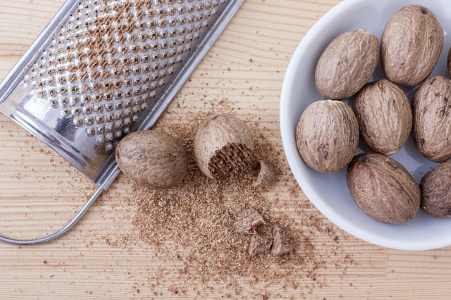
Grated nutmeg is used in both sweet and savory dishes
Myristica is the scientific name of the spice we commonly know as nutmeg. As its name suggests, nutmeg is the nut or seed of a tree that has a fragrant aroma and warming sweet taste.
The hard seed is grated into a powder and used to add warm spicy flavors to sweet and savory dishes. Nutmeg is often combined with cinnamon in spice mixes and is popular in Caribbean, Indonesian, Indian, and European cuisine.
If you want to use nutmeg in cooking, it goes well with lamb, tomato dishes, and vegetable stews. Due to is warming, comforting aroma, it is a popular ingredient in cold weather drinks such as mulled wine.
Mace
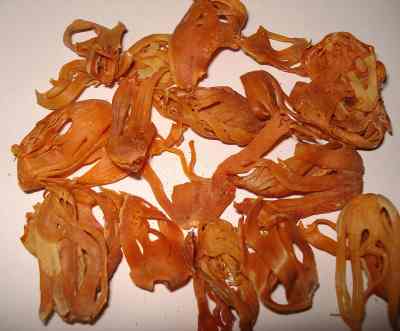
Mace is the coating on the nutmeg seed
This spice comes from the same seed as nutmeg. It is the reddish covering around the nutmeg seed and has a taste similar to nutmeg, only milder. When it is dried, mace becomes yellow-brownish in color. Because of its milder taste, mace is commonly used in desserts to give sweet hints of lemon and a delicate nutmeg flavor.
Cayenne Pepper
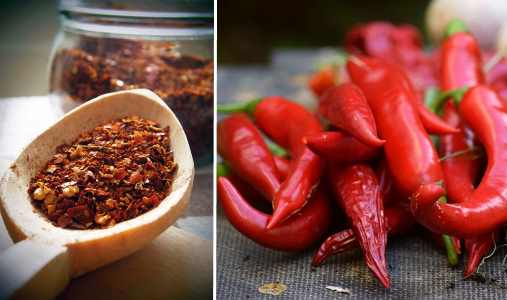
Cayenne pepper also comes as flakes and ground powder
Cayenne pepper is a red, hot, spicy powder that is made by grinding dried cayenne peppers. Adding cayenne pepper to any meal will give it heat and a sharp, biting taste. Cayenne pepper goes well with seafood, curries, casseroles, and hot sauces.
Some types of cayenne pepper can be a mixture of various chilies. This is usually a hot, pungent spice, but you can also find milder versions if you want the chili taste without the heat.
Paprika
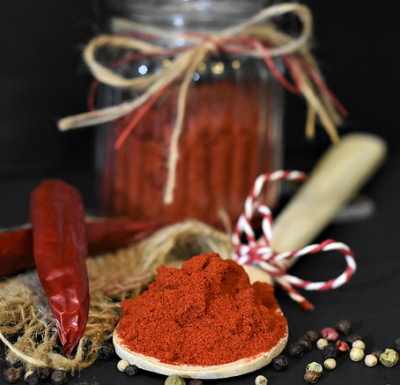
Paprika can be sweet, hot or smoked
The difference between cayenne pepper and paprika is that paprika is ground from dried bell peppers, not hot chilies. Sweet paprika is used in dishes to give them a sweet, yet slightly earthy taste.
Other forms of paprika include hot paprika, which is the main ingredient of Hungarian goulash. Or, there is smoked paprika if you want to add smokiness to a stew or barbeque sauce.
Chili Pepper

Chili gives red hot seasoning to dishes
Chili pepper is similar to cayenne pepper and is the perfect ingredient to add extra spice and heat to Caribbean, Indian, or Mexican dishes.
Chili powder can also refer to a blend of spices that are used in Latin American cooking. The list of spices in chili power can include chili powder, paprika, cumin, garlic powder, and oregano.
Fennel
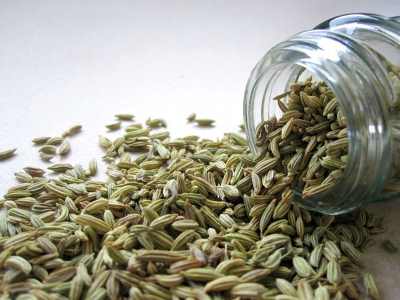
Fennel seeds are commonly used in Mediterranean dishes
Fennel (Foeniculum vulgare) is listed among some of the sweeter spices and has a light licorice flavor and aroma. Because it grows in Mediterranean countries, the ground seeds are used in French, Italian, Spanish, and Middle Eastern dishes. Fennel taste is also similar to anise spice, and the two spices are often confused.
In exotic dishes, ground fennel seeds are also used in spice mixes for Chinese cuisine (five-spice powder), and it is one of the main spices in Indian garam masala.
Fennel leaves are also on the list of aromatic herbs to use in cooking.
Onion Powder

Onion powder (left) and onion flakes (right)
Onions (Allium cepa) are one of the most versatile vegetables, and ground onion powder is an excellent seasoning spice for almost any dish. Dehydrated onion powder can be used to make homemade spice mixes, added to hamburgers, or as an ingredient in stews, soups, or marinades.
You can also use dried onion powder as a seasoning in place of salt and sprinkle it on pizzas, chicken, or use as a meat rub.
Coriander Seeds
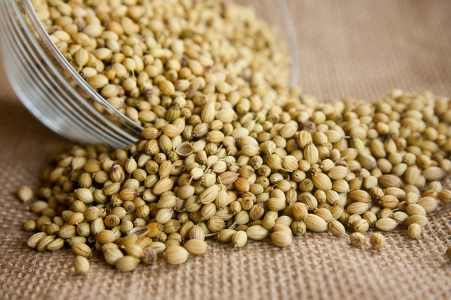
Coriander seeds can be ground to dried powder
When coriander seeds are used whole or ground, it is a culinary spice with a sweet citrusy taste. Coriander spice is a crucial ingredient in Mexican and Indian dishes. The lemon flavors of the spice are usually enhanced by adding fresh coriander (cilantro) leaves as an herb.
To increase the pungency and aroma of the small brown round seeds, you should dry fry them with other spices to release the essential oils.
Cumin
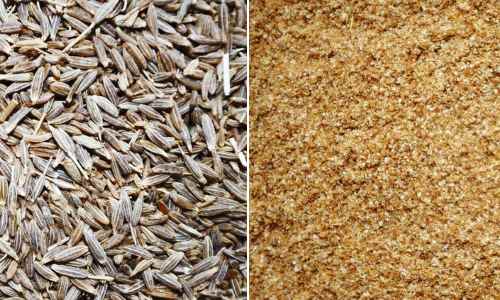
Cumin seeds (left) and cumin powder (right)
Cumin has the Latin name Cuminum cyminum, which helps differentiate it from spices with a similar name such as black cumin.
In many Asian, African, Mexican, Tex-Mex, and Indian cuisines, cumin spice is used together with coriander and other aromatic spices. Cumin seeds are used whole or ground in cooking to add a spicy, nutty flavor with earthy overtones.
Cumin was also used widely in ancient Greek, Moroccan, and Roman cuisine. Some countries still call Cuminum cyminum “Roman cumin.”
Caraway Seed
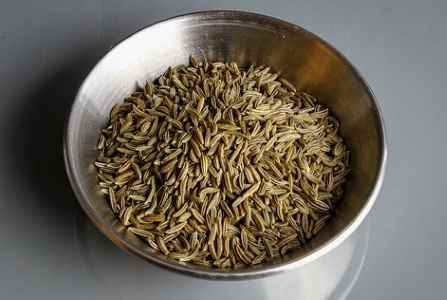
Caraway seeds look similar to cumin seeds
Caraway (Carum carvi) is related to cumin and is also known by the common names meridian fennel or Persian cumin. Looking at caraway seeds together with cumin seeds, you will see that they look almost identical.
Whole caraway seeds are often used in desserts, cakes, and rye bread. This pungent, anise-like spice is popular in Eastern European cuisine where is used to top scones, flavor cheese, and flavor liqueurs.
Black Cumin
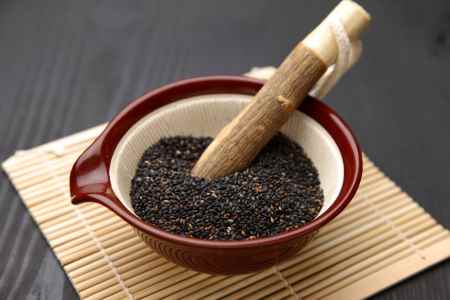
In the picture: Black cumin seeds (Nigella sativa)
Also called black caraway, black cumin (Nigella sativa) is not related to caraway seeds or brown cumin seeds. The dry-roasted black seeds are popular in Indian and Middle Eastern cuisine where they give dishes a pungent, bitter taste. This type of black cumin spice is also the ingredient to make black seed oil.
There is another kind of spice with the name black cumin (Bunium bulbocastanum). This spice is related to cumin seed and caraway seeds and has a smoky, earthy taste.
If your recipe says to use black cumin seeds, check to make sure which type of spice it is referring to.
Mustard Seeds
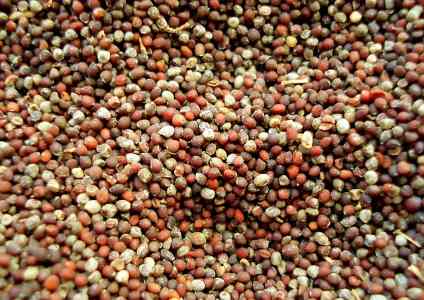
Mustard seeds add spicy sharp flavor to various dishes
Mustard seeds (Brassica alba) are tiny seeds that can be black, brown, white, or yellow. This is another kind of spice with an ancient tradition. Ground mustard seeds are combined with vinegar, water, and other spices to make prepared mustard. This is a popular condiment to flavor and spice up dishes. They are also commonly used in Indian cuisine.
Mustard seeds are commonly used whole when pickling cucumbers (gherkins) and other vegetables.
Cardamom

Cardamom is a popular spice in the Indian cuisine
Cardamom (also called cardamon) has the name “Queen of Spice” in India due to its extensive use and strong aromatic nature. This is one of the spices on this list that can be used in both savory and sweet dishes. The two types of spice commonly used are black cardamom and green cardamom.
Black cardamom has a strong smoky flavor to bring intensity to curries and other spicy dishes. Green cardamom has a sweeter taste and is used both in desserts and curries.
Clove
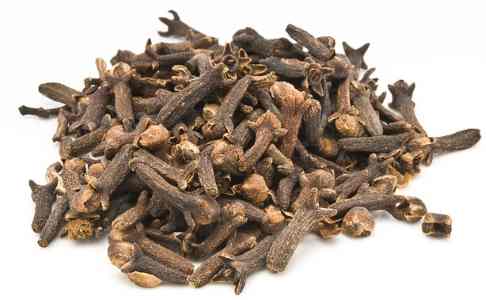
Cloves can be used to season both sweet and savory dishes
Clove spice is the aromatic dried buds of the clove tree. The unique, intense flavor and sweet taste of clove make it a popular spice in many cuisines. The taste of clove spice goes exceptionally well in sweet desserts containing apple, rhubarb, or pumpkin.
In savory dishes, clove is often combined with cumin and cinnamon as a spice blend. Other spice flavors that clove complements are onion, star anise, allspice, and peppercorns.
Celery Seeds
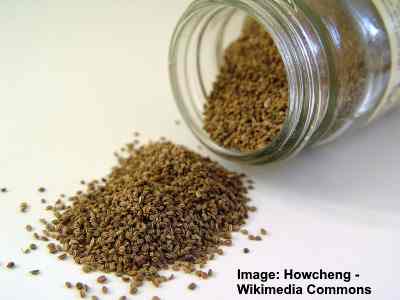
Celery seeds are a lesser-known but highly flavorful spice derived from the same plant family as the well-known celery stalks and leaves. These tiny brown seeds, harvested from the wild celery plant (Apium graveolens), are packed with intense flavor and offer a range of culinary uses.
Celery seeds have a concentrated celery flavor, with a bitter and slightly spicy undertone, making them an excellent choice for enhancing a variety of dishes.
Celery seeds are commonly used in:
- Pickling: Celery seeds are a traditional ingredient in pickling brines, lending a distinct flavor to pickles and relishes.
- Salad Dressings and Coleslaws: Their pungent taste is a great addition to salad dressings, coleslaws, and potato salads.
- Soups and Stews: A pinch of celery seeds can deepen the flavor profile of soups, broths, and stews.
- Marinades: These seeds can be used in marinades for meats or vegetables, infusing them with a subtle, earthy flavor.
- Spice Blends: Celery seeds are often included in spice blends, such as Old Bay Seasoning, and can be ground into powders for dry rubs.
When using celery seeds, it’s essential to remember that their flavor is much more potent than fresh celery. Thus, they should be used sparingly to avoid overpowering a dish. They can be used whole or ground, depending on the texture and flavor intensity desired in the recipe. Toasting the seeds briefly in a dry skillet can help release their aromatic oils, enhancing their flavor.
Fenugreek

Fenugreek seeds
Fenugreek is an essential spice in Indian and Middle Eastern cooking. Many types of curry powder contain toasted fenugreek seeds in their spice mix.
The seeds look like pale yellow pebbles. When toasted, their essential oils release a spicy, yet sweet aroma.
Allspice

Allspice is popular spice in many Caribbean dishes
The name “allspice” would suggest that this is a spice mix. However, allspice (Pimenta dioica) is the unripe berry of the tree called Jamaica pepper or myrtle pepper. The name allspice comes from the fact that the dried berry has aromas of cinnamon, nutmeg, and clove.
Allspice is one of the essential spices in many Caribbean dishes and is used to make jerk chicken. Due to its popularity, it is also used in desserts and savory dishes in the North American, European, and Arab cuisine.
Anise seed
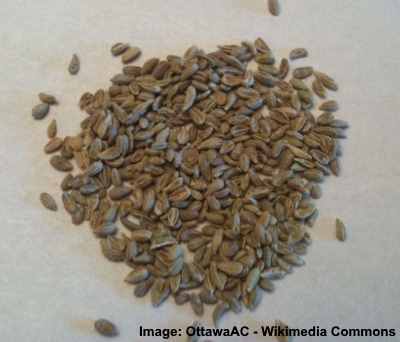
Anise seeds are used to flavor alcoholic drinks
Also called aniseed or sweet cumin, anise (Pimpinella anisum) has an aroma and taste similar to fennel and licorice.
In Mediterranean cuisine, anise seeds are commonly used to flavor alcoholic drinks. The Greeks call their drink ouzo, the Italians name theirs sambuca, and the French name for their anise drinks are pastis and pernod.
In other countries, the sweet taste of anise seeds makes them perfect for making refreshing teas and various types of candies.
Star Anise
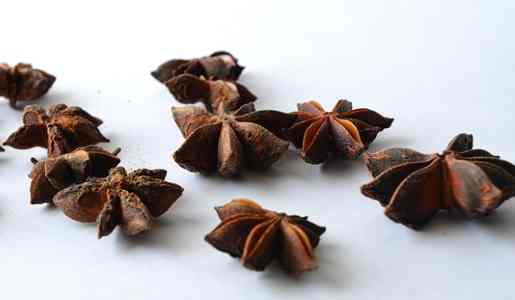
Ground star anise is used in five spice powder mix
Star anise (Illicium verum) is similar in aroma, flavor, appearance, to anise. However, this type of seed is from a different family and is native to China. In traditional Asian and Chinese cooking, this spice is used to flavor various dishes. It is also one of the spices used in Chinese five-spice.
Due to its lower costs and aniseed-like fragrant aroma, star anise is now a popular substitute for anise in Western countries.
Sumac

Ground sumac
Sumac (Rhus coriaria) is a red-colored spice obtained from the ground berries of the sumac plant. This flowering shrub grows in Africa, East Asia, and North America. The fantastic spice is a deep reddish-purple color and has a tangy lemon taste. Many Middle Eastern and Indian dishes contain sumac spice for its zesty tartness.
Poppy Seeds
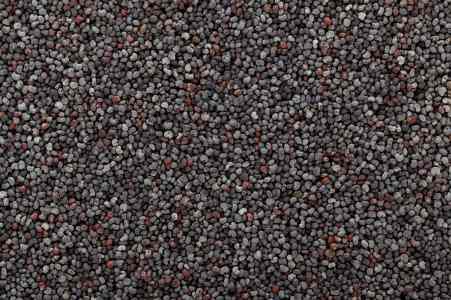
Poppy seeds are often used to top baked goods
Poppy seeds are tiny oily seeds often seen topping delicious bagels, muffins, pastries, and sponge cakes.
These tiny black seeds are not just for decoration. They have a nutty taste when you bite into them.
Juniper Berries

Juniper berries are a unique and versatile spice often overlooked in culinary uses. Contrary to their name, they are not true berries but the female seed cone from various species of junipers, with Juniperus communis being the most widely used. These ‘berries’ are actually small, fleshy cones with a distinctive bluish hue and a piney, somewhat citrusy flavor profile.
Juniper berries are a staple in European cuisine, particularly in dishes from Scandinavian, German, Eastern European, and Mediterranean regions. They are famously used in the preparation of gin, lending the spirit its characteristic woody, resinous flavor.
In cooking, juniper berries are often crushed or used whole to infuse meats, especially gamey flavors like venison, duck, and lamb, with a robust, earthy taste. They’re also a key ingredient in traditional sauerkraut recipes and are used to flavor certain hearty stews and soups.
When cooking with juniper berries, it’s important to remember that a little goes a long way due to their strong flavor. They pair well with other aromatic spices like rosemary, thyme, and sage. It’s recommended to crush the berries before using them to release their flavorful oils. Additionally, juniper berries can be used in spice rubs, marinades, and even as a seasoning for certain cocktails.
Za’atar

Za’atar is a distinctive and aromatic spice blend that has deep roots in Middle Eastern cuisine. The name ‘Za’atar’ also refers to a herb from the thyme family, but in the culinary context, it typically denotes a mixture of spices that includes sumac, sesame seeds, and herbs such as dried thyme, oregano, or marjoram.
The specific recipe for za’atar can vary by region and even by individual households, leading to a delightful diversity in flavors and uses.
Culinary Uses of Za’atar
Za’atar is incredibly versatile and is used in various culinary applications:
- Seasoning for Meats and Vegetables: It’s commonly used as a rub for meats, poultry, and vegetables, adding a herby and nutty flavor.
- Bread Dip: Mixed with olive oil, za’atar makes for a delicious dip for bread, particularly traditional flatbreads like pita.
- Flavoring for Dips and Spreads: It’s often added to dips like hummus or labneh (a Middle Eastern strained yogurt) to enhance their flavor.
- Sprinkling on Savory Dishes: Za’atar can be sprinkled on various dishes, including salads, yogurts, and eggs, to add a zesty, tangy twist.
- Roasted Nuts and Snacks: The spice blend can be used to season nuts and chips for a flavorful snack.
Sesame Seeds

Sesame seeds are small, oil-rich seeds that come from the Sesamum indicum plant, one of the oldest oilseed crops known, domesticated over 3,000 years ago. These seeds are not only notable for their rich, nutty flavor but also for their variety in colors, which include white, black, and brown hues.
Culinary Uses of Sesame Seeds
Sesame seeds are incredibly versatile in the culinary world:
- Topping for Breads and Rolls: Commonly sprinkled on top of bread, hamburger buns, and bagels, they add a nutty crunch. White sesame seeds are often used for this purpose.
- Ingredient in Sauces and Dressings: Ground sesame seeds, especially the white variety, are used to make tahini, a key ingredient in hummus and many Middle Eastern sauces.
- In Sweets and Desserts: In Asian cuisines, black sesame seeds are used in making sweets and confections, such as the Japanese Goma-dofu (sesame tofu) or the Chinese sesame seed balls.
- For Flavoring: Toasted sesame seeds, both black and white, are used to add flavor to various dishes, including stir-fries, salads, and noodle dishes.
- As Oil: Sesame oil, derived from the seeds, is a fundamental cooking medium in many Asian cuisines, known for its distinctive flavor.
Color Varieties of Sesame Seeds and Their Uses
- White Sesame Seeds: These are the most common variety and have a slightly milder flavor. They’re often used in baking and to top bread.
- Black Sesame Seeds: Known for their stronger, earthier flavor, they’re a staple in many Asian dishes, both in savory and sweet contexts.
- Brown Sesame Seeds: Less common than the other two, these have a more robust flavor and are often found in whole seed form.
Whole Spices vs Ground Spices
When using spices, you have the option to choose between whole spices and ground spices. Each form offers unique benefits and can impact the flavor of your dishes in different ways.
Whole Spices
Whole spices are the unground, complete dried form of the spice. They are often preferred for several reasons:
Longer Shelf Life: Whole spices retain their flavor and potency for a longer period compared to their ground counterparts. This makes them ideal for stocking in your pantry for extended use.
Flavor Preservation: The essential oils and aromatics in whole spices are better preserved, providing a fresher and more intense flavor when ground just before use.
Ideal for Certain Spices: Some spices, like saffron threads, cinnamon sticks, and whole peppercorns, are traditionally used in their whole form to infuse flavor into dishes.
The primary drawback of whole spices is the need for grinding them before use, which can be a bit of a task for harder spices.
Ground Spices
Ground spices are the powdered form of the whole spices and come with their own set of advantages:
Convenience: They are ready to use, making them a time-saver for busy cooks. There’s no need for additional preparation or special equipment to grind them.
Potency in Small Doses: Ground spices tend to be more potent, flavor-wise, than whole spices. This means you can use less to achieve the desired taste.
However, ground spices do have a shorter shelf life. They lose their potency and flavor relatively quickly as their essential oils evaporate over time.
Tips for Using Whole vs Ground Spices
When substituting one for the other, remember that ground spices are more potent. You’ll generally need less ground spice than whole spice. A common rule of thumb is to use one part ground spice to three parts whole spice.
For the freshest flavor, consider grinding whole spices yourself as needed. This ensures maximum flavor and aroma in your dishes.
Store ground spices in a cool, dark place and use them within six months for the best flavor. Whole spices can last up to a year or more if stored properly.
Related articles:
